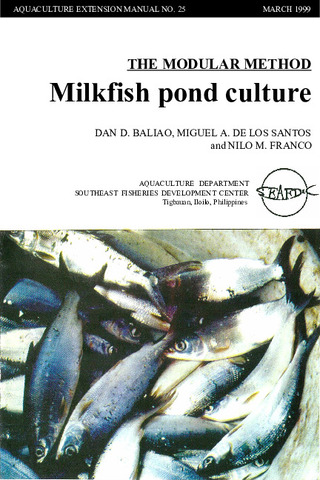Survival of captive milkfish Chanos chanos Forsskal broodstock subjected to handling and transport
- Global styles
- MLA
- Vancouver
- Elsevier - Harvard
- APA
- Help

View/
Date
2000Page views
1,730AGROVOC keyword
Taxonomic term
Metadata
Perlihat publikasi penuh
Share
Abstract
The survival of milkfish broodstock (body weight range 1–11 kg) was determined until 30 days after handling and transport in open tanks or in sealed oxygenated bags containing chilled sea water (20–25 °C). Maintenance of cool sea water was achieved by the gradual addition of ice chunks or frozen gel packs. A survival rate of 50% after transporting fish at a loading density of 45 kg m−3 for 4 h in open tanks was not significantly different from those that were handled but not transported (86%). Similarly, survival rates (67–83%) among broodstock confined for 8 h in chilled sea water at 40 and 60 kg m−3 were not significantly different from each other or from a group not subjected to confinement. Nevertheless, low dissolved oxygen (DO) and accumulation of total ammonia–nitrogen beginning 1 h after transport and confinement may be responsible for low survival rates of milkfish in open tanks. In contrast, all milkfish survived 10 h of overland transport in sealed bags with chilled and diluted (28 g L−1) sea water. Likewise, all milkfish survived after being bagged and immediately transferred to a communal rearing tank, or bagged and placed in a styrofoam box for 10 h. Except for total ammonia–nitrogen levels, which increased slightly (0.7–0.8 mg L−1) above background, seawater temperature (20–24 °C), salinity (28 g L−1) and DO (6 to > 20 mg mL−1) titres in transport bags were maintained during the 10-h test. The effectiveness of handling and transporting milkfish broodstock in sealed bags containing chilled sea water was verified in actual field trials. Spawning of sexually mature milkfish subjected to these stressors was not impaired. These results demonstrate that mortalities of large milkfish broodstock can be minimized when fish are handled and transported in sealed oxygenated bags containing chilled sea water.
Suggested Citation
Garcia, L. M., Hilomen-Garcia, G. V., & Emata, A. C. (2000). Survival of captive milkfish Chanos chanos Forsskal broodstock subjected to handling and transport. Aquaculture Research , 31(7), 575-583. https://doi.org/10.1046/j.1365-2109.2000.00475.x
Type
ArticleISSN
1355-557XKoleksi
- Journal Articles [1256]
Related items
Showing items related by title, author, creator and subject.
-
Series: Aquaculture extension manual; No. 25
The modular method: Milkfish pond culture
Baliao, Dan D.; de los Santos, Miguel A.; Franco, Nilo M. (Aquaculture Department, Southeast Asian Fisheries Development Center, 1999)The modular method of milkfish culture (Chanos chanos) described in the manual is an improvement over the traditional extensive method. The manual is intended for the use of fish farmers and aquaculturists, extensionists, ... -
Evaluation of organic and inorganic fertilizers in brackishwater milkfish ponds
Bombeo-Tuburan, Isidra; Agbayani, Renato F.; Subosa, Precilla F. (Elsevier, 1989)The study was conducted in twelve 144-m2 ponds to evaluate the effect of different organic and inorganic fertilizers on the growth, survival, gross production, and profitability of marketable milkfish. The ... -
Milkfish breeding and hatchery technology at SEAFDEC/AQD
Unknown author (Aquaculture Department, Southeast Asian Fisheries Development Center, 1999)Describes the techniques already adopted by the private sector: broodstock management, broodstock diet, commercial fry production, live transport, and larval diet. A list of AQD research publications on milkfish is included.






